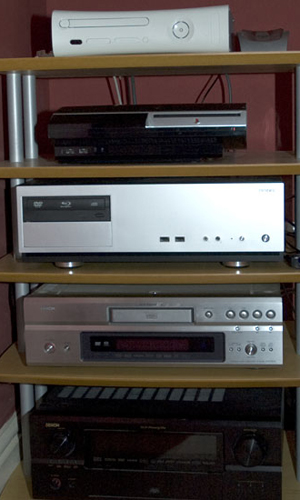Building a DVD Server
Every industry has its holy grail. For the games industry, it's the idea of a worldwide multi-format smash hit that will generate sequel after sequel. For football (or Soccer, to you lot on the other side of the Atlantic), it's the idea of a manager who will finally get England to the finals of the World Cup and win.For the last few years, my chosen field has been the AV industry, and I've even started running my own home cinema company. In that industry, the Holy Grail already exists, and it's called Kaleidescape. This is, to put it bluntly, one of the sexiest pieces of equipment in an industry that's inundated with gorgeous kit – it's a full-blown multi-zone DVD server capable of streaming DVD or BluRay movies anywhere around the house, with full 1080p upscaling for DVDs and the ability to filter and browse your movie collection from the comfort of your armchair.
Now, this may sound like something that's fairly obvious to the average reader here at bit-tech, but then you have to remember that the average bit-tech reader is light years ahead of the average bloke on the street when it comes to technical know-how. A Kaleidescape system is not only powerful; it's easy to use too.

There's only one problem with Kaleidescape systems – the price. With full system prices measured in tens of thousands of pounds, these systems are out of the reach of all but the mega-rich. Even cheaper alternatives such as Axonix's MediaMax system have enough zeroes on the price to elicit a sharp intake of breath through the teeth, from most people.
So, there you have it. A system that is gorgeous in its implementation and simplicity, yet too expensive for most of us to ever be able to afford. My quest, nay, my holy grail, is to see whether I could build a system with the functionality of a Kaleidescape system but without the jaw-dropping price tag.
A Tale of Few Parts
Both the Kaleidescape and MediaMax solutions use a full-blown client/server setup, with storage and cataloguing being handled by a fairly beefy RAID5 server, and lightweight players in each room. There’s a sound reason for this: the whole idea behind these DVD servers is that they’re multi-room, capable of playing different movies in different rooms simultaneously.That makes sense from both a manufacturer’s point and a consumer’s point: while it might make the upfront cost of a system quite high, it does keep the cost of the actual player that sits under the TV relatively low, which in turn makes extending the system beyond one room relatively cheap as well.
In fact, the whole system setup should be quite easy to replicate: after all, there are only really three parts to the system: a RAID server to handle the storage; some software to catalogue the film collection; and something to actually play the films themselves. A bit of networking (wired Gigabit is the preferred choice for playing HD content flawlessly) to join the whole lot together and we have ourselves a DVD server solution.
All I needed to do was work out what each of the individual components would be...

MSI MPG Velox 100R Chassis Review
October 14 2021 | 15:04









Want to comment? Please log in.